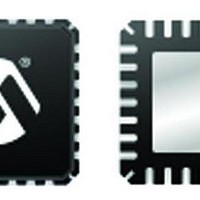DSPIC33FJ32GP204-H/ML Microchip Technology, DSPIC33FJ32GP204-H/ML Datasheet - Page 97

DSPIC33FJ32GP204-H/ML
Manufacturer Part Number
DSPIC33FJ32GP204-H/ML
Description
16-bit DSC, 44LD,32KB Flash,40 MIPS,nanoWatt 44 QFN 8x8x0.9mm TUBE
Manufacturer
Microchip Technology
Series
dsPIC™ 33Fr
Datasheet
1.DSPIC33FJ16GP304-IPT.pdf
(284 pages)
Specifications of DSPIC33FJ32GP204-H/ML
Core Processor
dsPIC
Core Size
16-Bit
Speed
40 MIPs
Connectivity
I²C, IrDA, LIN, SPI, UART/USART
Peripherals
Brown-out Detect/Reset, POR, PWM, WDT
Number Of I /o
35
Program Memory Size
32KB (32K x 8)
Program Memory Type
FLASH
Ram Size
2K x 8
Voltage - Supply (vcc/vdd)
3 V ~ 3.6 V
Data Converters
A/D 13x12b
Oscillator Type
Internal
Operating Temperature
-40°C ~ 140°C
Package / Case
44-VQFN Exposed Pad
Processor Series
dsPIC33F
Core
dsPIC
Data Bus Width
16 bit
Interface Type
SPI, I2C, UART, JTAG
Number Of Programmable I/os
35
Operating Supply Voltage
3.3 V
Maximum Operating Temperature
+ 140 C
Mounting Style
SMD/SMT
Development Tools By Supplier
MPLAB IDE Software
Minimum Operating Temperature
- 40 C
On-chip Adc
10 bit, 13 Channel
Lead Free Status / RoHS Status
Lead free / RoHS Compliant
Eeprom Size
-
Lead Free Status / Rohs Status
Details
- Current page: 97 of 284
- Download datasheet (4Mb)
7.4
7.4.1
To configure an interrupt source at initialization:
1.
2.
3.
4.
7.4.2
The method used to declare an Interrupt Service
Routine (ISR) and initialize the IVT with the correct
vector address depends on the programming language
(C or Assembler) and the language development
toolsuite used to develop the application.
In general, the user application must clear the interrupt
flag in the appropriate IFSx register for the source of
interrupt that the ISR handles. Otherwise, the program
will re-enter the ISR immediately after exiting the
routine. If the ISR is coded in assembly language, it
must be terminated using a RETFIE instruction to
unstack the saved PC value, SRL value and old CPU
priority level.
© 2011 Microchip Technology Inc.
dsPIC33FJ32GP202/204 and dsPIC33FJ16GP304
Note:
Set the NSTDIS bit (INTCON1<15>) if nested
interrupts are not desired.
Select the user-assigned priority level for the
interrupt source by writing the control bits in the
appropriate IPCx register. The priority level will
depend on the specific application and type of
interrupt source. If multiple priority levels are not
desired, the IPCx register control bits for all
enabled interrupt sources can be programmed
to the same non-zero value.
Clear the interrupt flag status bit associated with
the peripheral in the associated IFSx register.
Enable the interrupt source by setting the
interrupt enable control bit associated with the
source in the appropriate IECx register.
Interrupt Setup Procedures
INITIALIZATION
INTERRUPT SERVICE ROUTINE
At a device Reset, the IPCx registers are
initialized such that all user interrupt
sources are assigned to priority level 4.
7.4.3
A Trap Service Routine (TSR) is coded like an ISR,
except that the appropriate trap status flag in the
INTCON1 register must be cleared to avoid re-entry
into the TSR.
7.4.4
All user interrupts can be disabled using this
procedure:
1.
2.
To enable user interrupts, the POP instruction can be
used to restore the previous SR value.
The DISI instruction provides a convenient way to
disable interrupts of priority levels 1-6 for a fixed period
of time. Level 7 interrupt sources are not disabled by
the DISI instruction.
Note:
Push the current SR value onto the software
stack using the PUSH instruction.
Force the CPU to priority level 7 by inclusive
ORing the value OEh with SRL.
TRAP SERVICE ROUTINE
INTERRUPT DISABLE
Only user interrupts with a priority level of
7 or lower can be disabled. Trap sources
(level 8-level 15) cannot be disabled.
DS70290G-page 97
Related parts for DSPIC33FJ32GP204-H/ML
Image
Part Number
Description
Manufacturer
Datasheet
Request
R

Part Number:
Description:
IC, DSC, 16BIT, 12KB, 40MHZ, 3.6V, DIP28
Manufacturer:
Microchip Technology
Datasheet:

Part Number:
Description:
Manufacturer:
Microchip Technology Inc.
Datasheet:

Part Number:
Description:
Manufacturer:
Microchip Technology Inc.
Datasheet:

Part Number:
Description:
Manufacturer:
Microchip Technology Inc.
Datasheet:

Part Number:
Description:
Manufacturer:
Microchip Technology Inc.
Datasheet:

Part Number:
Description:
Manufacturer:
Microchip Technology Inc.
Datasheet:

Part Number:
Description:
Manufacturer:
Microchip Technology Inc.
Datasheet:

Part Number:
Description:
Manufacturer:
Microchip Technology Inc.
Datasheet:

Part Number:
Description:
Manufacturer:
Microchip Technology Inc.
Datasheet:










